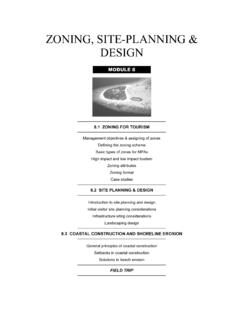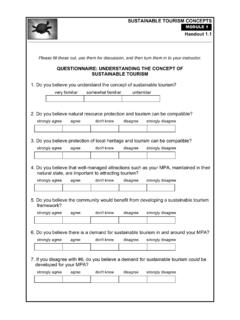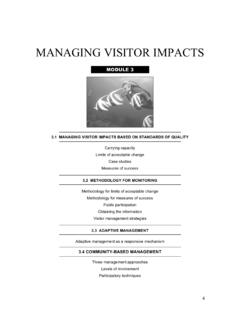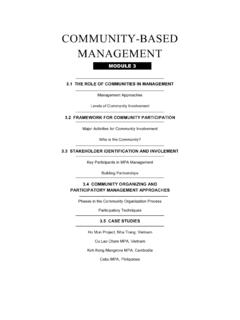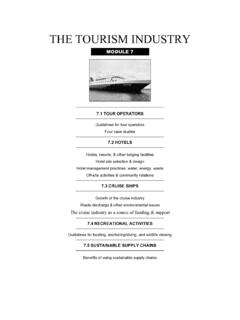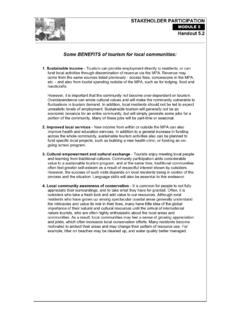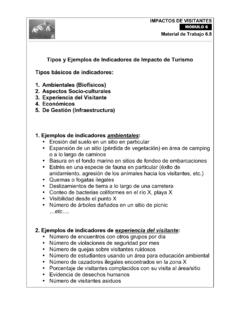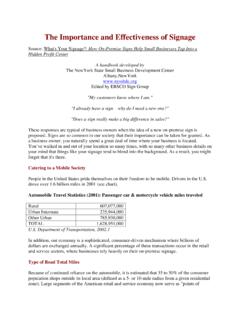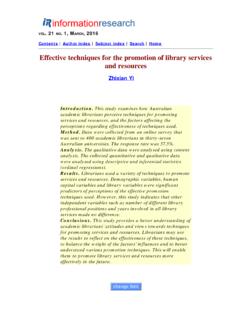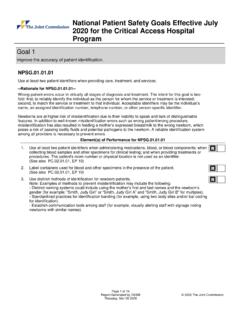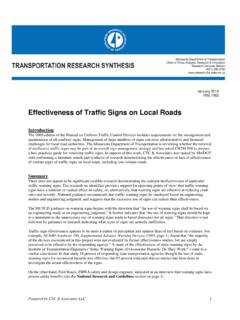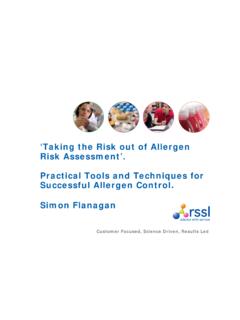Transcription of SUSTAINABLE TOURISM
1 SUSTAINABLE TOURISM OVERVIEW OF SUSTAINABLE TOURISM SUSTAINABLE TOURISM , What Does it Mean? What are the Benefits and Threats for TOURISM ? Is There a Demand for SUSTAINABLE TOURISM ? MANAGING VISITOR IMPACTS Carrying Capacity Case Study: Seychelles Management Approach to Carrying Capacity Best Management Practices Awareness Building THE PLANNING PROCESS What is a SUSTAINABLE TOURISM Plan? What are the Prerequisites? How Do You Finance a SUSTAINABLE TOURISM Program? Case Study: Cat Ba SUSTAINABLE TOURISM Program Who Prepares a SUSTAINABLE TOURISM Plan?
2 Preliminary Site Evaluation Final Site Diagnostic Data Analysis Phase GREEN CERTIFICATION What Does it Mean? Who Benefits from Green Certification MODULE 10 Acknowledgements The majority of the following material comes from: Drumm, Andy and Moore, Alan. An Introduction to Ecosystem Planning, Second Edition. The Nature Conservancy, Arlington, Virginia, USA, 2005 IUCN 2004. Managing Marine Protected Areas: A Toolkit for the Western Indian Ocean. IUCN Eastern African Regional Programme, Nairobi, Kenya. 172p. With additional information from: Christ, Costas; Hillel, Oliver; Matus, Seleni; and Sweeting, Jamie.
3 TOURISM and Biodiversity, Mapping TOURISM s Global Footprint. Conservation International and UNEP, Washington, DC, USA, 2003 Bien, Amos. The simple user s guide to certification for SUSTAINABLE TOURISM and ecotourism. The International Ecotourism Society. August 2004 SUSTAINABLE TOURISM 10-1 MODULE 10 OVERVIEW Taking advantage of the world-wide market for TOURISM can bring benefits to MPAs; it can also bring costs to the community, the economy and the environment if not managed properly. TOURISM is one of the largest global industries, with much of the growing market focused around pristine natural environments such as coastal and marine protected areas.
4 MPAs are increasingly attracting interest from foreign visitors, as well as local residents. The regions around MPAs are also attracting the interest of investors and the travel industry, seeking new destinations and markets. Local communities can benefit through revenue generation and employment opportunities. However, if not properly managed, TOURISM development can also put pressure on natural resources, destroy habitat, disturb wildlife and pollute waters. Poorly managed TOURISM can result in social and cultural impacts, undermining local communities.
5 Many MPAs are promoting TOURISM and recreation as part of their management planning, thus need a clear policy on how to implement a SUSTAINABLE TOURISM program. Part of SUSTAINABLE TOURISM planning is identifying and adhering to being responsive to the carrying capacity limitations of the MPA, both in terms of impacts on natural resources and the local community. When carrying capacity is exceeded, it can also impact the experience for the visitor due to over -crowding (too many visitors) and degraded ecosystems. importance OF SUSTAINABLE TOURISM TO EFFECTIVE MPA MANAGEMENT Well managed SUSTAINABLE TOURISM can contribute directly to marine conservation needs and provide tangible economic opportunities to the local community.
6 SUSTAINABLE TOURISM empowers the community to manage their own resources and cultural heritage in a SUSTAINABLE manner. SUSTAINABLE TOURISM can also be used as a financing mechanism through the generation of revenues from entrance fees, user fees, taxes or concession fees, to fund marine protected area management. LEARNING OBJECTIVES To identify SUSTAINABLE TOURISM mechanisms that provide conservation, social and economic benefits to MPAs and their local communities. To understand the planning and implementation process for a successful SUSTAINABLE TOURISM program.
7 SUSTAINABLE TOURISM 10-2 MODULE 10 LINKS TO OTHER EFFECTIVE MANAGEMENT AREAS Community-based Participatory Processes SUSTAINABLE TOURISM planning is a participatory process that includes government, development agencies, TOURISM industry, private sector, and local communities in incorporating marine conservation principles into the design, planning, development, and management of TOURISM products and services. Zonal Management SUSTAINABLE TOURISM planning includes prohibiting high impact visitor activities in buffer zones or conservation corridors, while encouraging low impact activities.
8 Alternative Livelihoods and Poverty Reduction With developing countries carrying the majority of the growth in SUSTAINABLE TOURISM , TOURISM can provide less destructive alternative livelihood opportunities to local communities. SUSTAINABLE TOURISM focuses on retaining TOURISM revenues within the local community and reducing revenue leakage to outside the community, or even country. Marine Conservation SUSTAINABLE TOURISM can make a direct contribution to marine conservation by managing and directing visitor use in sensitive areas; encouraging low impact activities; and educating visitors about the significant cultural and natural resources of the area.
9 SUSTAINABLE Financing SUSTAINABLE TOURISM provides MPA managers with additional sources of revenue from visitor entrance fees, use fees, TOURISM taxes and donations which help to fund more effective MPA management and capacity building. Awareness Building Effective SUSTAINABLE TOURISM planning includes raising visitor awareness through the training of guides, visitor centers, signage and brochures; promoting community involvement and interest in conservation issues; educating government officials and decision makers on building a governance framework and infrastructure that supports SUSTAINABLE TOURISM ; and educating TOURISM providers (airlines, hotels, boats, concessions, etc.)
10 About best management practices. SUSTAINABLE TOURISM 10-3 MODULE 10 INDICATORS OF EFFECTIVE SUSTAINABLE TOURISM Program evaluation should be part of every MPA s management plan. A systematic approach needs to be taken to evaluate the effectiveness of the SUSTAINABLE TOURISM program. Since SUSTAINABLE TOURISM is not just about economics, but also about conservation and the community, there are three primary goals that should be achieved if the program is successful (The Nature Conservancy 2005): 1) Threats to conservation targets are reduced 2) Income is generated for conservation 3) Local communities are benefited In measuring whether these goals have been met, it must be understood whether the benefits are actually generated as a result of the SUSTAINABLE TOURISM program by itself.
